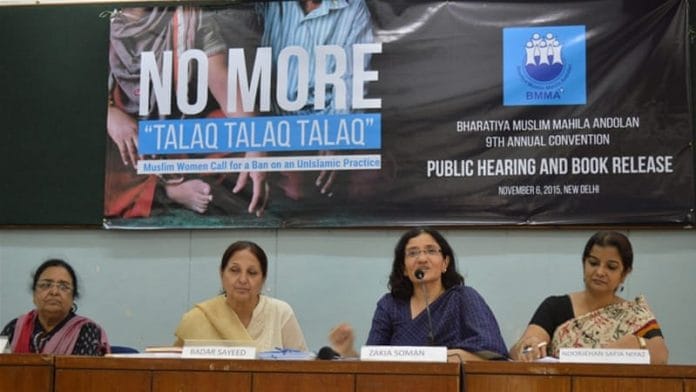The most interesting response to the ‘internal’ diversity of a religious minority has come from the women’s groups. The Bharatiya Muslim Mahila Andolan (BMMA), a leading Muslim women’s organisation, has been campaigning against the prevalent divorce practices amongst many Muslims communities in India known as ‘triple talaq’ (uttering of the word talaq by husband three times in one go to divorce his wife) for a long time. Although the BMMA subscribes to the position taken up by the Supreme Court in triple talaq case that this practice must legally be abolished, the organisation finds one universal common civil code (UCC) for all religious groups a politically motivated project. In one of the reports published by the BMMA, it is argued:
Muslim orthodoxy in India does not want to entertain any talk of personal law reform and the Hindu right is pushing for the Uniform Civil Code … both these sections are coming from extreme points of view and both are equally patriarchal. The credentials of both these formations on the question of gender justice and place of women in society are far from impeccable …. There is no clarity about what is meant by Uniform Civil Code in the BJP manifesto of 2014. Are they calling for the abolition of the Hindu Marriage Act, 1955?… On the other hand, the Muslim conservatives cannot keep their minds and eyes shut to the atrocities such as triple talaq. (No More Talaq Talaq Talaq: Muslim Women Call for Ban on an Un-Islamic Practice, BMMA, 2016, p. 5)
This argument very broadly underlines the ‘minority within minority’ argument. The BMMA wants gender-just Islamic reforms and they are not reluctant to invite the state to initiate the process; yet, the organisation does not wish to give up the distinctive Muslim identity as a minority in the name of UCC.
Also read: Modi govt has been working for a Uniform Civil Code and we didn’t even notice. Until now
The contest between ‘undefined minority’ and ‘defined minority’ found an interesting manifestation in relation to the recent debate on citizenship. In July 2016 the government introduced the Citizenship Amendment Bill in the Lok Sabha. The Bill amends the Citizenship Act, 1955 to make the migrants who are Hindus, Sikhs, Buddhists, Jains, Parsis and Christians from Afghanistan, Bangladesh and Pakistan eligible for Indian citizenship as illegal. The statement of the Objective of the Bill says:
Many persons of Indian origin including persons belonging to … minority communities from the aforesaid countries have been applying for citizenship under section 5 of the Act, but are unable to produce proof of their Indian origin. Hence, they are forced to apply for citizenship by naturalisation under section 6 of the Act, which, inter alia, prescribes twelve years residency as the qualification for naturalisation in terms of the Third Schedule to the Act. This denies them many opportunities and advantages that may accrue only to the citizens of India, even though they are likely to stay in India permanently. It is proposed to amend the Third Schedule to the Act to make applicants belonging to minority communities from the aforesaid countries eligible for citizenship by naturalisation in seven years instead of the existing twelve years. (The Citizenship Amendment Bill, 2016).
The bill, as it appears, relies heavily on the defined category called religious minority in only three neighbouring countries (Afghanistan, Bangladesh and Pakistan) where Muslims are in a majority. In this sense, the bill seems to underline the argument that the religious configuration of minority-majority in India is inextricably linked to particular countries of South Asia.
This discussion brings us to two fundamental questions:
- Does the act of defining religious minorities at the national level in the post-1992 period symbolise a departure from the established constitutional principle that does not offer any fixed interpretation of the term minority? Or, is it an extension of the principle—an attempt to fill up the emptiness of the official category called minority?
- Minority politics—especially Sikh and Muslim politics—employed two interesting modes to carve out spaces for themselves. During the 1960s minority politics was played out in the name of language (Punjabi Suba, protection of Urdu, etc.) whereas in the 2000s the minority debate shifted to social justice arguments evoking backwardness as a ‘criterion’ to protect ‘distinctiveness’. This shifting character of minority politics makes the question of representation very relevant. In other words, we must ask: What are the emerging forms of minority representation?
Also read: Assam wanted an end to its ethnic conflict. In the end, it got an NRC that nobody accepts
This excerpt from Democratic Accommodations: Minorities in Contemporary India by Peter Ronald deSouza, Hilal Ahmed, Mohd. Sanjeer Alam has been published with permission from Bloomsbury India.






